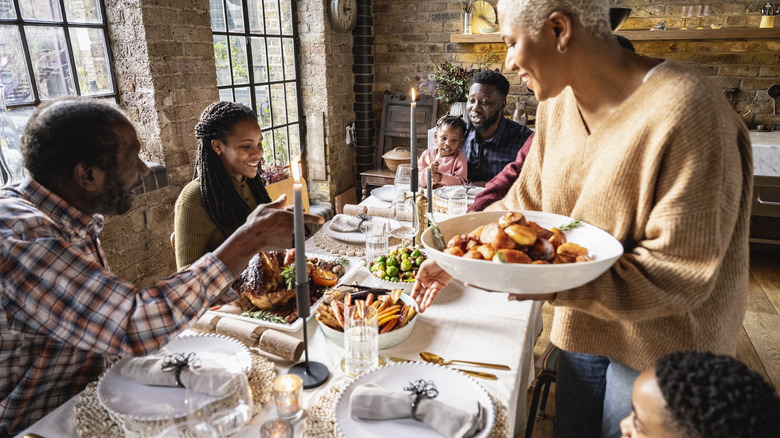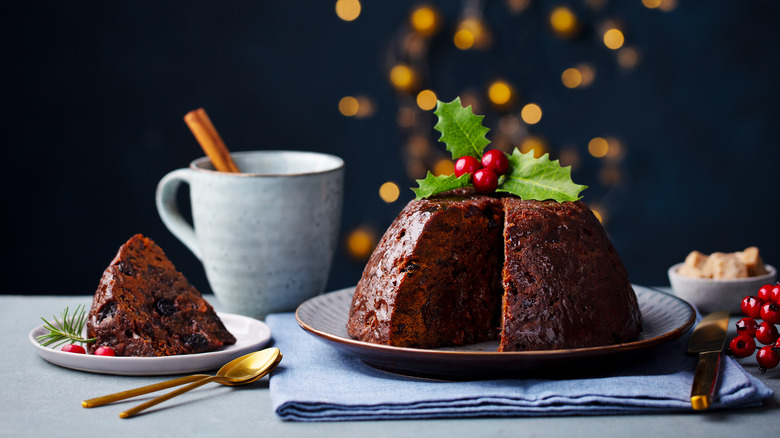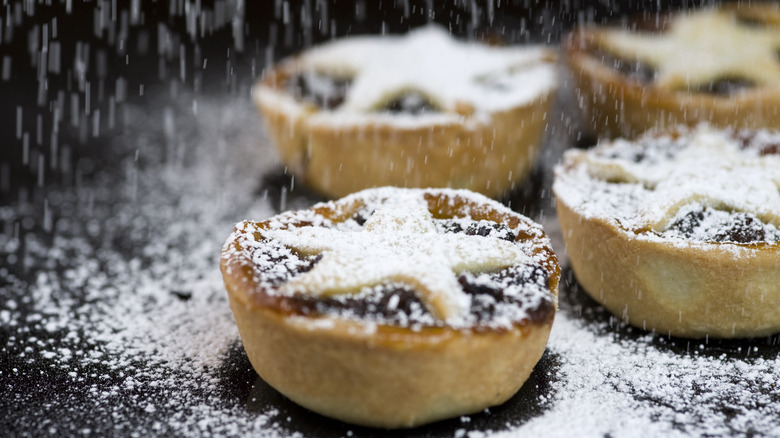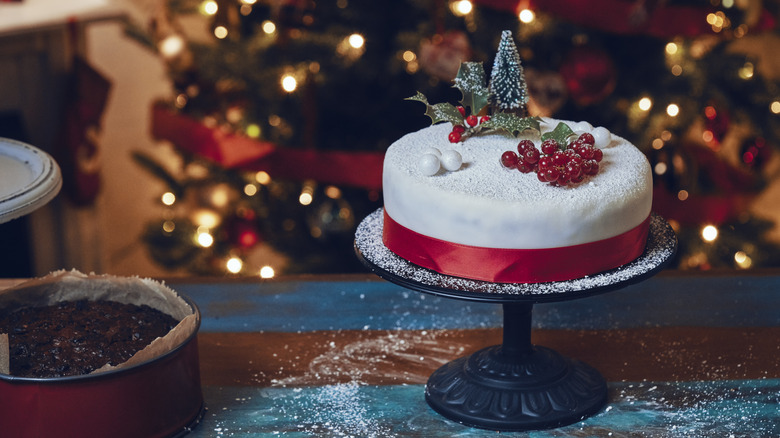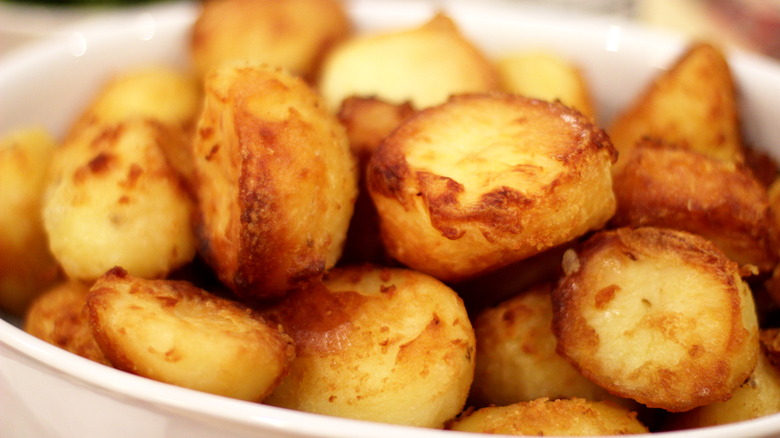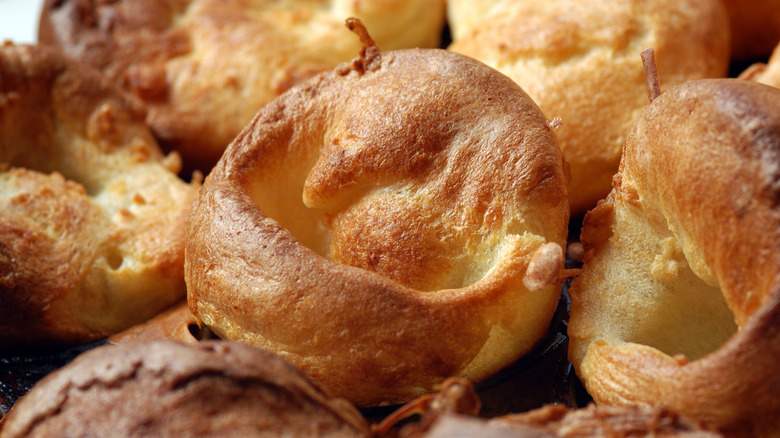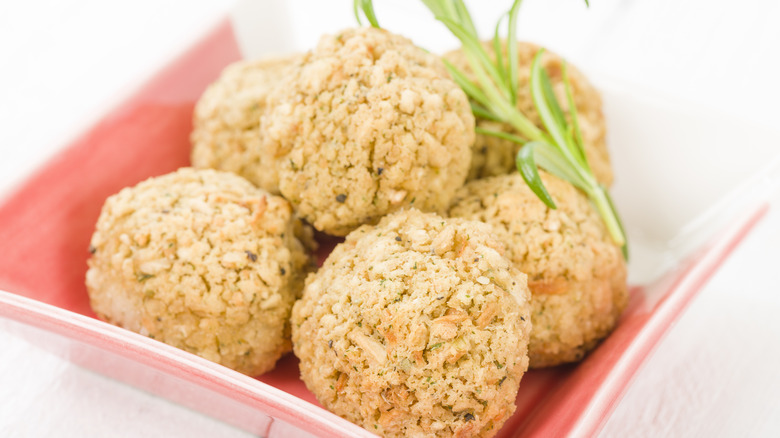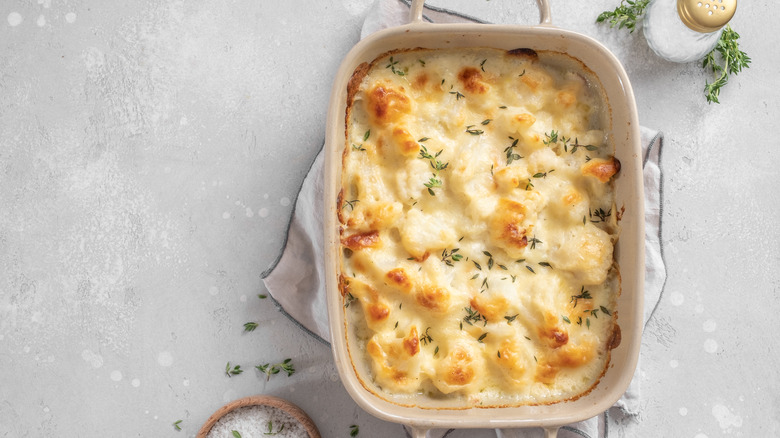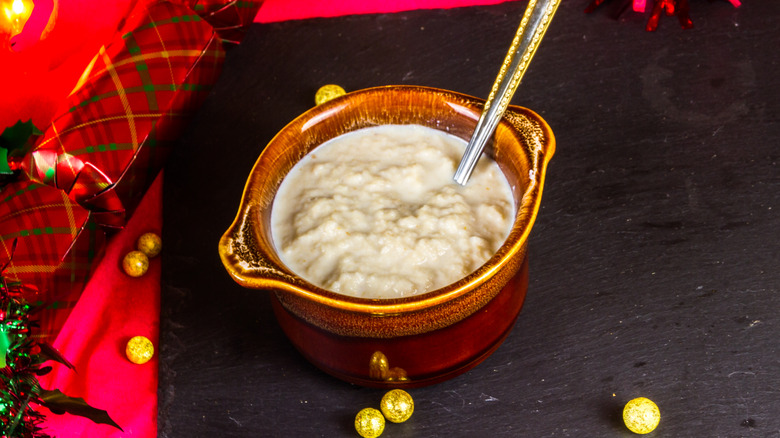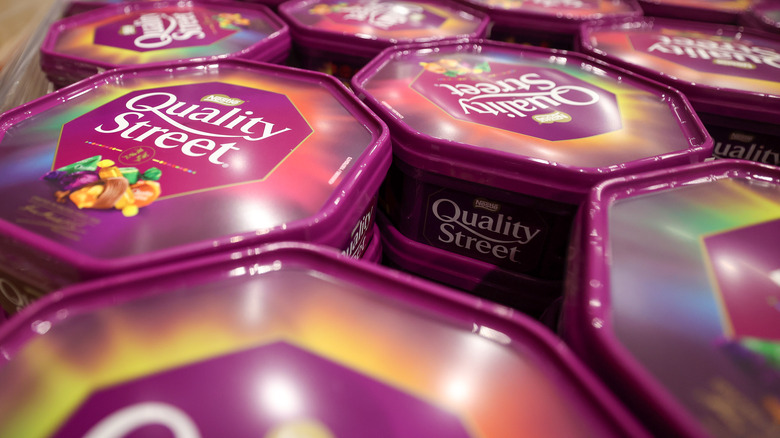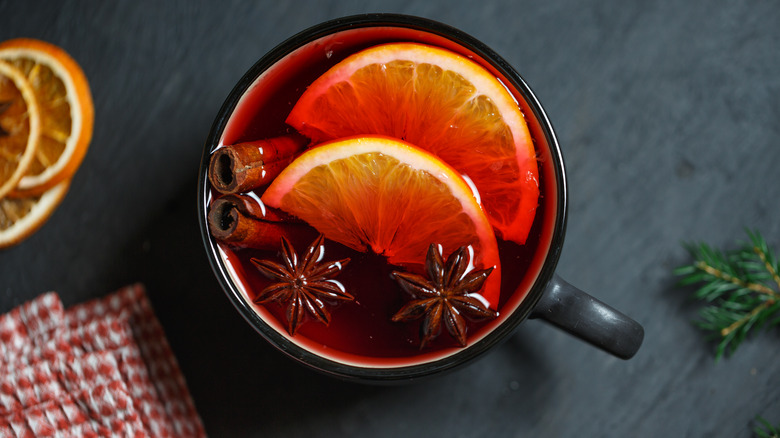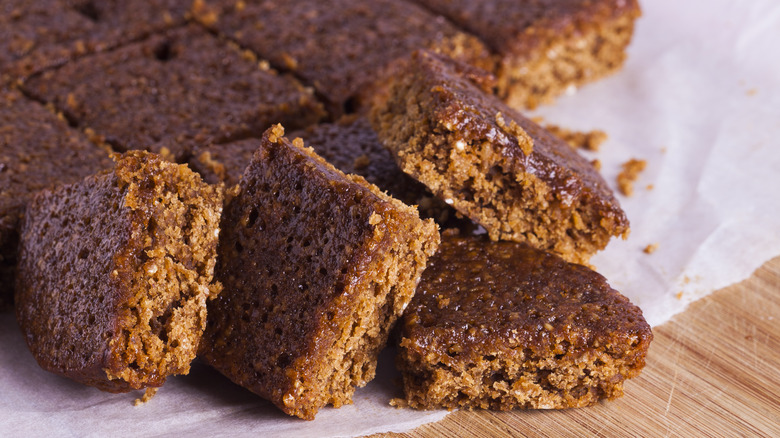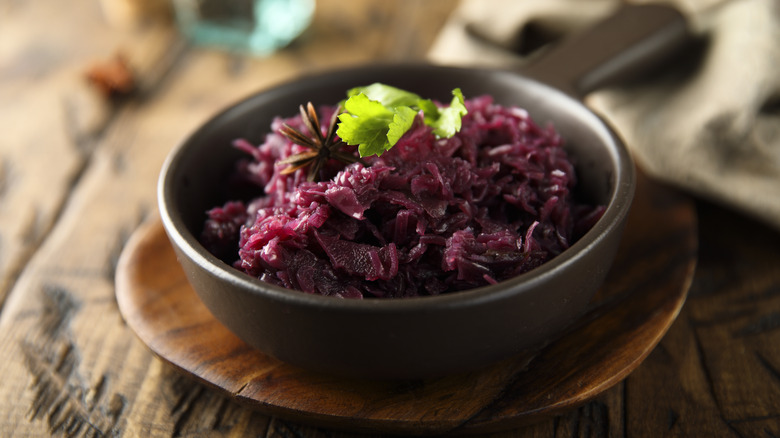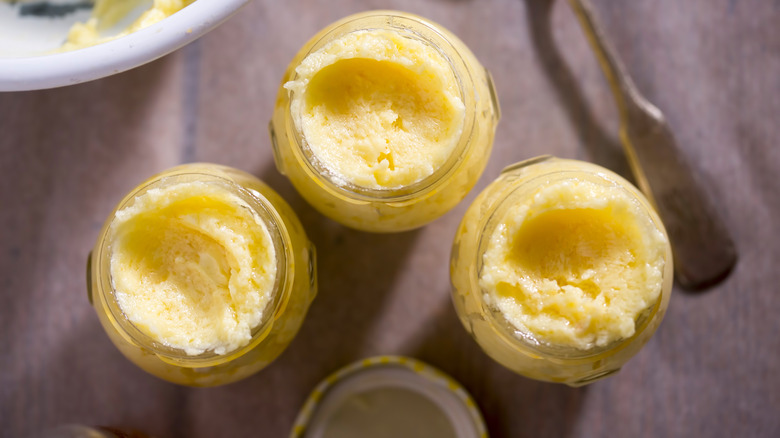13 British Christmas Foods You Need To Try Before You Die
'Tis the season, and it's time to start decking the halls and daydreaming about Christmas food. You probably have your own Christmas food traditions. If you live in the U.S., your festive food could be something that looks similar to Thanksgiving dinner. Or, if your family comes from an immigrant background, it could be anything from tamales to German sausages and potato salad, to pierogies and sauerkraut. But in the U.K., things are a bit different.
There are a range of traditional British Christmas foods, some of which date back centuries. But, of course, there are also newcomers to the table. For instance, there's a war waging in households all over the British Isles between two of the most popular Christmas chocolate selection boxes: Roses and Quality Street. The War of the Roses, some might say. And, whether you're an Anglophile or you're just interested in sampling foods from around the globe, you might be curious about what these British festive foods taste like.
We're about to go on a tour of 13 British Christmas foods you need to try before you die. As a Brit, I have opinions, but I've also gathered thoughts from chefs, food bloggers, and food history buffs, and researched some of the most popular recipes.
1. Christmas pudding
Christmas pudding has its origins back in the early 1400s — although it has changed a lot since then. It's also known as plum pudding or figgy pudding. If you're expecting something with the consistency of an American pudding, you'd be sorely mistaken. This is a sponge pudding, meaning it's kind of a dense steamed cake. But there's so much dried fruit in it that it's really more dried fruit than sponge. The sponge part is more like the mortar holding the dried fruit together. It's generally heavy on the raisins, but it can also contain currants, sultanas, and other dried fruits. However, despite its alternative names, it doesn't usually contain figs or plums.
Christmas pudding is traditionally served for dessert on Christmas Day in the U.K. Some people make it themselves, but it's more common to buy one ready-made from the supermarket, where you'll find them in abundance. That said, Christmas pudding can be divisive. At any dinner table, you'll usually find those who love Christmas pudding, those who hate the stuff, and a third group of people who don't like it all that much but always eat a spoonful or two because it's traditional. In a display of Christmas excess, it's often doused in brandy, and set alight before serving. People often eat it with cream or brandy butter (more on that later).
2. Mince pies
If somebody told you that mince pies are pies filled with mincemeat, you might imagine something packed with ground beef and gravy. But, no. Confusingly, mincemeat is the name given to a sweet mixture of dried fruits, mixed peel, suet (traditionally beef suet, but today it's usually vegetable suet), apples, brandy, and festive spices, such as nutmeg and cinnamon.
This mincemeat is stuffed inside a shortcrust pastry and baked. Mince pies are individually sized. They're usually quite small at around 1.5 to 2 inches in diameter, although you can occasionally find larger mince pies. It's fairly common for people to bake mince pies around Christmas in the U.K., but less common for them to make their own mincemeat since it's readily available in jars in grocery stores. You can also buy ready-made packs of mince pies, with a huge range appearing on shelves from late October or early November. What's more, it's not uncommon to find them for sale in cafés, coffee shops, and Christmas markets. So, if you're in Britain and you want to try a mince pie, you'll have plenty of opportunities.
3. Christmas cake
As Christmas approaches, it seems like all of the U.K. becomes obsessed with dried fruit — and Christmas cake is yet more proof of this. Honestly, it's a little bit like a baked version of Christmas pudding. It's a dense, dark sponge that's absolutely rammed with raisins, currants, candied peel, and other dried fruit. It's heavily spiced with the types of spices you expect to encounter around Christmas — cinnamon, nutmeg, ginger, or mixed spice blends.
But here's where it gets interesting — people who make their own Christmas cake generally bake it about two months before Christmas. They then feed it with brandy every two weeks to mature it. This helps to develop the flavors and also improves the shelf life while keeping it moist when a two-month-old cake should be anything but. When the time comes, it's usually covered with a layer of marzipan and then frosted in royal icing. Some people add inedible decorations to create a winter scene, such as Christmas trees or people sledding. Families may have these kinds of Christmas cake decorations passed through the generations. During the festive season, you can also buy Christmas cakes whole from grocery stores or by the slice from some cafés.
4. Roast potatoes
A British Christmas dinner wouldn't be complete without a sizable portion of roast potatoes. You might be thinking that there's nothing special or particularly British about that, but we beg to differ. Yes, you've probably eaten roasted potatoes before, but British roast potatoes are their own thing. They're bigger than you might be used to and exceptionally crunchy on the outside while incredibly fluffy on the inside. They're amazing and if you haven't tried them already, you need to.
To achieve this texture, you need to start with the right potato — it's common to use a floury variety like Maris Piper or King Edward in the U.K. Then, the cut potatoes need to be parboiled for about 10 minutes. Finally, they're roasted in a tray of hot oil for 45 minutes to an hour. Sometimes they're roasted with rosemary or garlic, but there's no need to get fancy. This combination of steps gives you the best roast potatoes you've ever had. There's nothing else quite like them.
This style of potato is also part of a classic Sunday roast. You'll find Sunday roasts served in pubs all over the U.K. on a Sunday, so it's easy enough to try them if you visit, even if it isn't Christmas time. You can also buy frozen roast potatoes that are pre-cooked and designed to be reheated in the oven — but we absolutely wouldn't recommend them.
5. Yorkshire puddings
We've already been through the pudding thing — British puddings just aren't the same as American pudding. But just when you think you've got a handle on what a British pudding is and isn't, here comes the Yorkshire pudding. Named after the English county in which they originated, Yorkshire puddings are served as a side with a roast dinner. Some people might try to tell you that they don't belong with Christmas dinner, but we say you don't need that kind of negativity in your life. While there are a few outliers, most British people are in favor of Yorkshire puddings for Christmas dinner. The beauty of the Yorkshire pudding is the dip in the center. It's the perfect well for gravy or sauces.
Yorkies, as they're sometimes called, are made from a batter of flour, milk, and eggs, and baked in either a Yorkshire pudding tin or muffin pans. Like roast potatoes, you'll find them served at many pubs on Sundays, as part of their roast dinner offering. You can also buy them frozen from supermarkets to cook at home. Aunt Bessie's is by far the most popular brand and is found at almost any sizable grocery store in the U.K.
6. Paxo stuffing
You might be used to classic American stuffing, which is made from fairly large cubes of bread, plus aromatics, such as onion and herbs. British stuffing, however, is quite different. While some people make their own stuffing from scratch, most people make it from a dry mix. To whip it up, you just add water and cook it in the oven. While there are many stuffing mixes available in the U.K., Paxo stuffing is by far the most popular.
So, what exactly is it? It's mostly made up of breadcrumbs and seasonings. One of the most popular options is sage and onion. As stuffing, it's technically designed to be stuffed inside a turkey before roasting. However, it's sometimes rolled into balls or cooked in a sheet pan to be served as a side. Most Paxo stuffing happens to be plant-based, so it makes a great meat-free side for vegetarians or vegans at Christmas.
7. Cauliflower cheese
Once seen as bland, cauliflower is having a bit of a resurgence in the U.S. — roasted cauliflower is popular, as are cauliflower wings. However, Brits arguably have the best cauliflower dish around — cauliflower cheese. This decadent dish is commonly served with a roast, particularly on Christmas Day, when people are putting more time and effort into their meals than they would on an average day.
To make this dish, cauliflower is cooked before being added to a cheese sauce (ideally homemade) and baked to finish. Some people add extra cheese or breadcrumbs on top, a little like mac and cheese. It's not always found on Sunday roasts served in pubs — but you might get lucky. You can also buy ready-made cauliflower cheese in some supermarkets that just needs to be put in the oven or microwave to heat it. Is it as good as homemade cauliflower cheese? No. But it's still cauliflower drenched in cheese sauce, and that's pretty great.
8. Bread sauce
Bread sauce — you know both words individually, but they don't make sense as a phrase. Well, for anyone wondering, bread sauce is exactly what it sounds like but you thought it couldn't possibly be — it's a sauce made from bread. If you're wondering exactly how that works, you're not alone. Bread might not have a pourable consistency, but that doesn't stop us from turning it into a sauce. We aren't going to let the laws of physics keep us from adding yet more carbs to our Christmas dinners.
Here's how the magic happens: stale bread is added to milk to soften it. It's flavored with onions, garlic, and Christmassy spices, such as nutmeg, mace, and cloves. The result is a thick, starchy sauce. It's a popular choice at Christmas and a throwback to the Middle Ages when sauces and stews thickened with bread were served at Christmas and on other feast days.
We know that sauce made with bread might not sound too appealing, but it's worth trying at least once. It's a popular Christmas staple for a reason — it's way more delicious than it sounds. While homemade bread sauce is best, you can also buy bread sauce mixes in British supermarkets. They consist of breadcrumbs and spices, and you just add milk and heat.
9. Roses and Quality Street Chocolate
While there are now some newer contenders on the market — such as Celebrations and Miniature Heroes — Roses and Quality Street are two of the U.K.'s most iconic chocolate selection boxes. Both have been around since the 1930s, so anyone who grew up in the U.K. within the last 90 years is well-acquainted with them. Although you can buy them all year round, Christmas is where they come into their own. You'll find huge tins and tubs lining supermarket shelves, and it would be rare not to be offered one or the other if you go to someone's house any time between Christmas Eve and New Year.
Now, we're not saying they have a deadly rivalry, but it's rare to meet a British person who doesn't have an allegiance to either Roses or Quality Street. Roses have nine flavors, including their signature truffle, hazelnut in caramel, and country fudge. Quality Street has 11 flavors, including caramel swirl, toffee penny, and iconic green triangle (which is chocolate hazelnut flavored). If you want to try these iconic festive candies, you can buy them any time of year in the U.K., so pick up a box of one or both if you come for a visit.
10. Mulled wine
We know that mulled wine is available in other parts of the world, as well, but the sheer volume of it available in the U.K. means it deserves a spot on this list. You can hardly go two paces without spilling some mulled wine on yourself in December. It's also been around in the U.K. for a long time. One of the earliest written recipes for it dates back to the 1500s, and people were sure to have been making and drinking it before then.
If you're not familiar with mulled wine, here's the deal. It's a red wine that's sweetened with sugar and flavored with citrus fruits and spices. It's usually made with slices of fresh oranges and whole spices, such as cloves and cinnamon sticks. The wine is heated up with these fragrant additions, which impart their flavor to the wine before being strained out. It's served hot, which is part of why it's such a popular winter drink.
People make it at home, but it's also available in most pubs and bars around Christmas time in the U.K. Not to mention at Christmas markets and other winter celebrations, such as Bonfire Night festivities. Or, if you want it at home without the effort, you can buy pre-mulled bottles of wine that you simply heat up on the stove.
11. Gingerbread
We all know what gingerbread is — or do we? Most people are more familiar with gingerbread cookies, which are firm with a snap to them. However, there's another type of gingerbread that's popular in Britain, especially around Christmas. It's neither a gingerbread cookie nor a classic yeast bread; it's more like a ginger cake than anything else. If you think of other quickbreads, such as banana bread or zucchini bread, then the name makes more sense.
British gingerbread has a complex, spicy flavor that comes from containing a lot of ground ginger. It also tends to contain some cinnamon, and sometimes other sweet, fragrant spices. The texture of the cake is dense and moist. It usually has treacle or molasses in it to impart that dark, rich flavor. Then, there are pieces of stem ginger for a sweet, spicy pop of flavor. You can sometimes find it in cafés, but it's quite traditional and more often homemade.
12. Braised red cabbage
If there's one vegetable side that is synonymous with British Christmas — Brussels sprouts aside — it's braised red cabbage. Some people who never would touch red cabbage for most of the year wouldn't dream of Christmas dinner without it. While at other times of the year, Brits might have red cabbage stir-fried, steamed, boiled, or raw in slaw or salads, when Christmas comes around, it's braised or nothing.
Braising red cabbage on low heat for a long time — sometimes a couple of hours — gives it a rich flavor and a soft, melt-in-the-mouth texture. For Christmas, it's generally cooked with aromatics to give it that festive touch. People might add onions, garlic, star anise, cinnamon sticks, cloves, or allspice berries. It's also common to add some Bramley cooking apple, which generally softens to almost nothing over the long cooking period, adding sweetness and thickening the braising liquid. There's also usually red wine vinegar added since acidic ingredients help red cabbage hold onto its vivid hue.
13. Brandy butter
How is it possible to improve butter? Well, the answer's simple — stick some booze and sugar in it and call it a day. Brandy butter is a traditional British dessert accompaniment during the festive season. It's a mixture of butter, brandy, and confectioner's sugar (known as icing sugar in the U.K.), all whipped together to give it a smooth, light consistency.
It might seem strange to the uninitiated, but it's delicious. Think of it as a boozy buttercream if that helps. It's usually eaten with festive sweets and desserts — particularly Christmas pudding and mince pies — in the same way that you might serve a pie with whipped cream. While it's easy enough to make at home, it's available in any big U.K. supermarket during the runup to Christmas. Many people buy it pre-made to eat with their Christmas desserts. It's rarely available outside the holiday season, though. So, if you want to try it, you'll need to be around at the right time.
